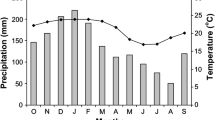Abstract
Long-term observational data of the phenological network of the German Weather Service (DWD) were used to derive the altitudinal dependence of leaf unfolding (LU), leaf discolouration (LD) and the length of the vegetation period (LD-LU) of common beech (Fagus sylvatica L.) in different regions of Southern Germany. Depending on altitude, the vegetation period starts in Bavaria between the 2nd and 24th May with a delay of around 2 days per 100 m altitude increase (averaged over the last 30 years). In Southern Bavaria, LU starts a few days earlier as well as increases slightly faster into higher altitudes than in the northern regions. This can be explained by a more favourable supply of warmth and radiation in the south. The end of the vegetation period, defined here as the beginning of LD, showed no altitudinal dependence, which reflects an interaction of endogenous and exogenous factors as triggers for LD. In the Bavarian Forest region, altitudinal dependences are strongly influenced by sites which are affected by cold-air tailback (‘Kaltluftstau’) was obtained. Hence, phenological gradients should only be derived and applied above a phenological inversion zone. The calculated vertical gradients for LU can be used together with available observational data to estimate the beginning of the forest vegetation period of beech for different altitudes of Bavaria.




Similar content being viewed by others
References
Aichele H (1964) Beitrag zur Festlegung phänologischer Jahreszeiten und deren Höhenabhängigkeit in Rheinland-Pfalz. Meteorologische Rundschau 17:42–46
Aulitzky H (1968) Über spezielle Erfordernisse des Phänologischen Beobachtungsdienstes eines Gebirgslandes. Wetter und Leben 20:16–19
Baumgartner A (1962) Die Lufttemperatur als Standortfaktor am Gr. Falkenstein (Bayer. Wald) (3. Mitteilung). Forstwissenschaftliches Centralblatt 81:18–47
Baumgartner A, Kleinlein G, Waldmann G (1956) Forstlich-phänologische Beobachtungen und Experimente am Großen Falkenstein (Bayerischer Wald). Forstwissenschaftliches Centralblatt 75:290–303
Bayerischer Klimaforschungsverbund (BayFORKLIM) (1996) Klimaatlas von Bayern, München
Brandtner E, Essenwanger O (1957) Zur Statistik phänologischer Daten. Meteorologische Rundschau 10:151–156
Chmielewski F-M, Rötzer T (2001) Response of the tree phenology to climate change across Europe. Agric For Meteorol 108:101–112
Chmielewski F-M, Rötzer T (2002) Annual and spatial variability of the beginning of growing season in Europe in relation to air temperature changes. Clim Res 19:257–264
Dittmar C, Elling W (1999) Jahrringbreite von Fichte und Buche in Abhängigkeit von Witterung und Höhenlage. Forstwissenschaftliches Centralblatt 118:251–270
Dittmar C, Fricke W, Elling W (2006) Impact of late frost events on radial growth of common beech (Fagus sylvatica L.) in Southern Germany. Eur J For Res, this volume
Elling W, Bauer E, Klemm G, Koch H (1987) Nationalpark Bayerischer Wald: Klima und Böden—Waldstandorte. Schriftenreihe des Bayerischen Staatsministerium für Ernährung, Landwirtschaft und Forsten, Band 1, 2. Aufl., 255 pp
Hänninen H (1991) Does climatic warming increase the risk of frost damage in northern trees? Plant Cell Environ 14:449–454
Heigel K (1957) Phänologische Beobachtungen auf dem Hohenpeißenberg während der Palatina-Zeit. Berichte des Deutschen Wetterdienstes 36:40–46
Hupfer P, Kuttler W (Hrsg.) (1998) Witterung und Klima. Teubner-Verlag, Stuttgart, 10. Aufl., 413 pp
König C, Mayer H (1988) Phänologie und Frühjahrswitterung unter dem Aspekt “Neuartige Waldschäden”. Wissenschaftliche Mitteilungen Nr. 61, Meteorologisches Institut, Universität München, pp. 11–19
Kramer K (1994) A modelling analysis of the effects of climatic warming on the probability of spring frost damage to tree species in The Netherlands and Germany. Plant Cell Environ 17:367–377
Larcher W (1984) Ökologie der Pflanzen auf physiologischer Grundlage. Verlag Eugen Ulmer, Stuttgart, 4. Aufl., 403 pp
Menzel A (1997) Phänologie von Waldbäumen unter sich ändernden Klimabedingungen—Auswertung der Beobachtungen in den Internationalen Phänologischen Gärten und Möglichkeiten der Modellierung von Phänodaten. Forstliche Forschungsberichte München 164:147 pp
Menzel A, Fabian P (2001) Veränderungen der forstlichen Vegetationszeit in den letzten Jahrzehnten in Deutschland. Beiträge zur Forstwirtschaft und Landschaftsökologie 35:188–191
Murray MB, Cannel MGR, Smith RI (1989) Date of budburst of fifteen tree species in Britain following climatic warming. J Appl Ecol 26:693–700
Rötzer T (1996) Neuartige Karten der Phänologie und des Wasserhaushaltes von Bayern unter Berücksichtigung möglicher künftiger Klimaverhältnisse. Dissertation an der TU München-Weihenstephan, p. 182 pp
Rötzer T, Chmielewski F-M (2001) Phenological maps of Europe. Clim Res 18:249–257
Rötzer T, Wittenzeller M, Häckel H, Nekovar J (2000) Phenology in central Europe—differences and trends of spring phenophases in urban and rural areas. Int J Biometeorol 44(2):60–66
Rötzer T, Grote R, Pretzsch H (2004) The timing of bud burst and its effect on tree growth. Int J Biometeorol 48:109–118
Schnelle F (1955) Pflanzen-Phänologie. Akademische Verlagsgesellschaft Geest & Portig K.-G., Leibzig, p. 299 pp
Schnelle F (1956) Ein Hilfsmittel zur Festlegung der Höhe von Frostlagen in Mittelgebirgstälern. Meteorologische Rundschau 9:180–182
Schnelle F (1966) Abriss einer Methodik der Phänologie. Mitteilungen des Deutschen Wetterdienstes 38:1–28
Schnelle F (1979) Phänologische Spezialkarten der Laubentfaltung und Laubverfärbung von Rosskastanie, Weißbirke, Rotbuche und Stieleiche auf dem Gebiet der Bundesrepublik Deutschland. Fachliche Mitteilungen des Amtes für Wehrgeophysik 196:33 pp
StatSoft Inc. (2004) STATISTICA für Windows (Software-System für Datenanalyse) Version 6. StatSoft Inc., Hamburg
Tranquillini W, Plank A (1989) Ökophysiologische Untersuchungen an Rotbuchen (Fagus sylvatica L.) in verschiedenen Höhenlagen Nord- und Südtirols. Centralblatt für das Gesamte Forstwesen 106(3):225–246
Acknowledgements
The authors thank the German Weather Service (DWD) for providing phenological data as well as Dr. Thomas Rötzer and Dr. Rob Wilson for their valuable contributions and critical review of the manuscript.
Author information
Authors and Affiliations
Corresponding author
Rights and permissions
About this article
Cite this article
Dittmar, C., Elling, W. Phenological phases of common beech (Fagus sylvatica L.) and their dependence on region and altitude in Southern Germany. Eur J Forest Res 125, 181–188 (2006). https://doi.org/10.1007/s10342-005-0099-x
Received:
Accepted:
Published:
Issue Date:
DOI: https://doi.org/10.1007/s10342-005-0099-x




